




| 83 Peace Monuments in Mid Atlantic States (USA) |








83 Peace Monuments in Mid Atlantic States (USA)
(Delaware, Maryland, North Carolina,
South Carolina, Virginia & West Virginia)
Click here for Washington, DC.
Right click image to enlarge.



October 12, 1792 & 1964 - Columbus Obelisk, Herring Run Park, Harford Road at Walther Avenue, Baltimore, Maryland (USA). Main inscription (smashed in 2017): "SACRED TO THE MEMORY OF CHRIS. COLUMBUS OCTOB. XII MDCC VIIIC [___]." Inscription on side tablet: "COLUMBUS MONUMENT RE-LOCATED FROM NORTH AVENUE EAST OF HARFORD ROAD AND RE-DEDICATED OCTOBER 12, 1964. THEODORE R. McKELDIN, MAYOR" /// "First monument to Columbus in the USA (& in the world). Donated by the French Consul to Baltimore, Charles Francois Adrian de Paulmier, Chevalier d'Anmour. Initially erected on the consul's 50-acre estate [Villa Belmont] at the corner of North Avenue & Harford Road...In 1887, Belmont became the Samuel B. Ready School...It moved to West Baltimore in 1938 to make way for Sears Roebuck’s huge store, which is now the Eastside District Court...The Columbus obelisk was moved to its present location in northeast Baltimore near Herring Run park in 1964...The obelisk, considered too fragile to be moved, was left behind on what became a Sears parking lot...Moved to the present location near the Samuel Ready Institute on Columbus Day, 1964." /// "Smashed with a sledgehammer on August 21, 2017, in opposition to the 'culture of white supremacy,' according to reports. The narrator goes on to refer to such statues to Columbus as 'slap in the face...Racist monuments to slave owners & murderers have always bothered me. Baltimore’s poverty is concentrated in African-American households, & these statues are just an extra slap in the face. They were built in the 20th century [sic] in response to a movement for African Americans’ human dignity. What kind of a culture goes to such lengths to build such hate-filled monuments? What kind of a culture clings to those monuments in 2017?'" /// Click here for a more complete history of the THREE Columbus monuments in Baltimore.
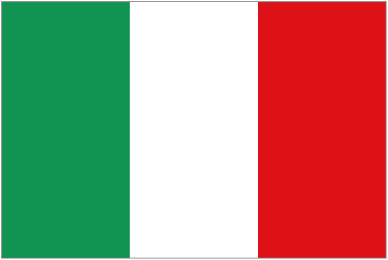





1806 - Tripoli Monument or Peace Monument, US Naval Academy (USNA), Annapolis, Maryland (USA). Made in Italy by Charles Micali. Originally erected in the Navy Yard, Washington, DC. Damaged by fire during War of 1812. Moved to West Grounds of the US Capitol in 1831. Moved to USNA in 1861. Plaque: "The oldest military monument in the United States honors heroes of the War against the Barbary Coast Pirates [1801-1805], the new republic's first war..." Renovated in June 2000.
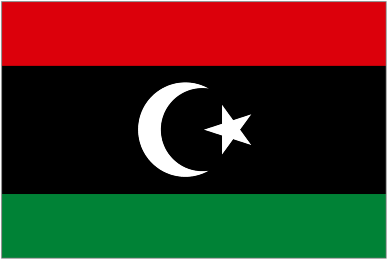



N/A - Slave Market, Charleston, South Carolina (USA). Unintentional monument


N/A - Old Slave Mart Museum, Charleston, South Carolina (USA). Unintentional 1902. Right image by EWL.


1985 - Franklin & Armfield Slave Market (also known as Price & Birch), 1315 Duke Street, Alexandria, Virginia (USA). "Still stands at this location. It was rededicated as Freedom Place in 1985, and is now on the National Register of Historic Places. The slave pen was one of the largest exporters of slaves to the South. The general route for slaves going South would start at the Franklin and Armfield Pen, after which slaves would then be taken to Market Square, then to the river to board ships that would take them to New Orleans, where they were dispersed to other southern areas."


N/A - Bruin's Slave Jail, 1707 Duke Street, Alexandria, Virginia (USA). "Joseph Bruin used this brick Federal-style dwellling as his holding facility, or 'slave jail' for slaves awaiting sale to individuals and other dealers. Bruin purchased the large house in 1844. Harriet Beecher Stowe, in The Key to Uncle Tom's Cabin (1854), described how she employed her knowlege of Bruin's slave jail as background for her explosive 1852 novel, Uncle Tom's Cabin. Currently used as business offices, and is not open to the public."





1853 - Okinawa Bell (Gokoku-ji), Bancroft Hall, US Naval Academy (USNA, Annapolis, Maryland (USA). Commodore Matthew C. Perry [1794-1858] carried an Okinawa temple bell to the USA & proposed that it be mounted atop the Washington Monument (then under construction) in Washington, DC. His widow donated the bell to the US Naval Academy where it was displayed on the grounds (left image circa 1902), then placed just outside Bancroft Hall, the academy's largest building (right image). In 1987, the bell was returned to Okinawa, and a replica now serves at the academy.



After 1854 - "Peace," Mount Vernon Square, Baltimore, Maryland (USA). One of four statues (War, Peace, Force & Order) at the ends of a balustrade that marks the corners of the square. Each consists of a neo-classic figure, a child & an animal. Designed by French sculptor Antoine-Louis Barye [1796-1875] & cast in 1854, the originals are in the Louvre in Paris. William Walters, founder of the Walters Gallery, donated them to the city. "It’s obvious that war & peace are set as opposites: so, we would think, are order & force."

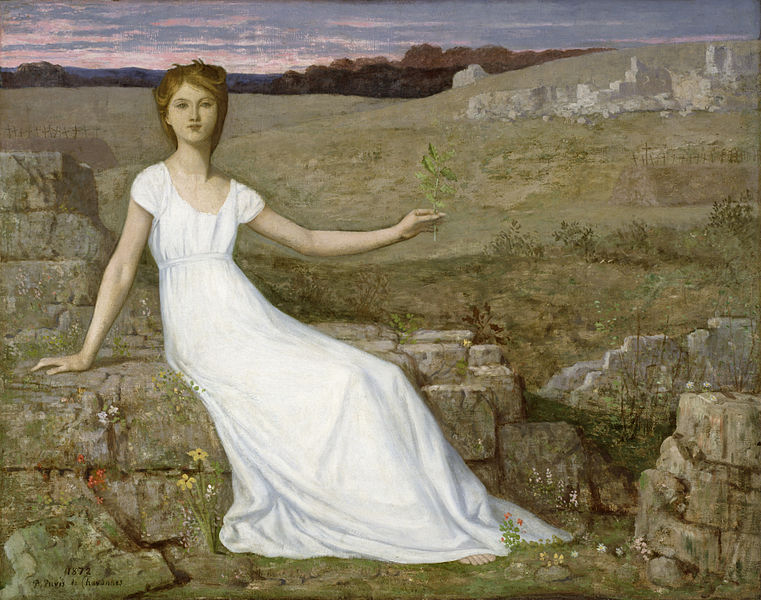

1872 - "Hope," a painting by French artist Pierre Puvis de Chavannes [1824-1898], Walters Art Museum, Mount Vernon Place, Baltimore, Maryland, USA. "A woman holds up an oak twig as a symbol of hope for the nation's recovery from war & deprivation after the Franco-Prussian War [1870-1871]."

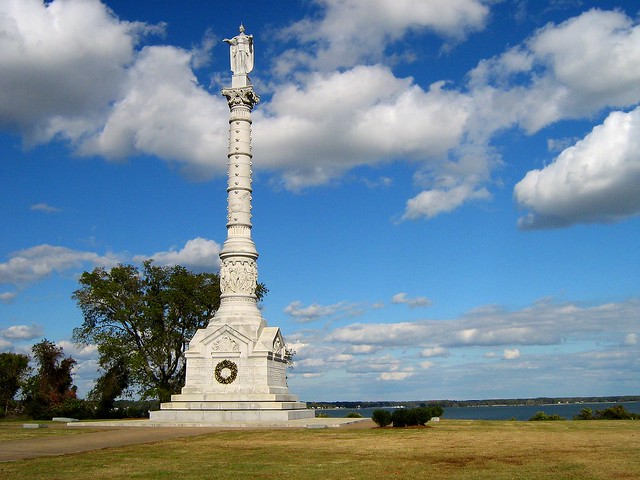


1884 - Yorktown Victory Monument Plaque, Yorktown, Virginia (USA). Inscription on 1984 plaque: "'We are now friends with England and with all of mankind.' Benjamin Franklin, 1783, American Peace Commissioner -- 'This great peace monument is a symbol of the sacrifices in lives and property in the Revolutionary War, which ended at Yorktown and which brought us our independence. It symbolizes, too, the peace between the mother country and America - a peace not seriously interrupted since 1781.' Horace M. Albright, 1931, Director, National Park Service -- 'The Treaty of Paris was the first step toward an alliance with Great Britain which has grown stronger through two centuries to become one of our most important alliance relationships. Political, Cultural, Economic, and defense ties between our two nations are firm and lasting.' Ronald Reagan, 1983, President, United States of America -- Dedicated 19 October 1984, Bicentennial Year, Ratification, Treaty of Paris"
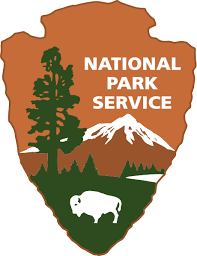


1885 - Peace statue, Mount Vernon Place, Baltimore, Maryland (USA). On the southwest corner of the Washington Monument. "The famous French artist Antoine-Louis Barye [1796-1875] created a series of monuments, each depicting a man, boy & beast that decorate the Place du Carrousel [at the] Louvre [in Paris]." /// "Barye took the traditional image of Hercules Resting as the starting point for these sculptures. In War, the figure is seated on a recumbent horse, which may represent victory or strength, but his upper body is tense and on the verge of action as the accompanying putto blows his heralding horn. In Peace, on the other hand, the main figure is resting against an ox, a symbol of peace, listening to a putto playing the flute. " /// "William Walters [1820-1894] purchased smaller bronze reproductions of War, Peace, Order & Force and donated them to the City of Baltimore. The Walters were strong supporters of Barye during his career. Their art gallery [also on Mount Vernon Place] contains over one hundred sculptures, paintings & sketches by the expert animalier. Along with the Barye Lion, War, Peace, Order and Force are on public display year round circling the George Washington Monument..."



M
U
S
E
U
M
1880's - Booker T. Washington National Monument, National Park Service (NPS), State Highway 122, 22 miles from Roanoke, Virginia (USA). "Following the Civil War, a patriotic organization purchased the Isaac Potts house as an historic site. By the 1880's, the house was open to the public." Created April 2, 1956, the National Monument "preserves portions of the 207-acre (0.90 km˛) tobacco farm on which educator and leader Booker T. Washington [1856-1915] was born into slavery on April 5, 1856, and interprets Washington's life and achievements." Described on pages 54-55 of "A Traveller's Guide to the Civil Rights Movement" by Jim Carrier (2004).


October 16, 1896 - Civil War Correspondents Memorial Arch, Gathland State Park, Crampton's Gap, Burkittsville, Maryland (USA). Built by George Alfred Townsend [1841-1914] who had been the youngest war correspondent of the Civil War.



1905 - "Fame," Salisbury, North Carolina (USA). Also known as "Confederate Monument." "A bronze statue of the muse Fame supports a defeated & dying soldier who clutches his gun; Fame, a winged figure dressed in robes & wearing a laurel wreath atop her head, holds a second wreath high into the air as if to place it on the soldier. The statue stands on a pink granite pedestal. From the bottom of the pedestal to the top of the bronze grouping the monument measures almost 23 feet. The United Daughters of the Confederacy (UDC) chapter decided on the statue in 1901. The completed statue arrived in Salisbury in 1905, but the land that the monument sits on wasn't deeded to the UDC until 1908 by the Salisbury Board of Aldermen & Mayor."
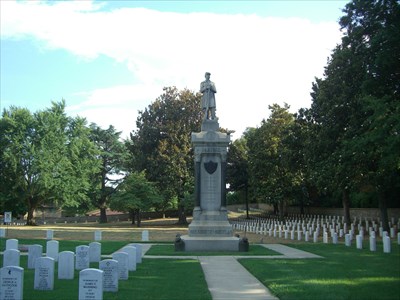

June 1908 - Maine Monument, Salisbury National Cemetery, 202 Government Road, Salisbury, North Carolina (USA). This & the Pennsylvania monument were built because of the significant number of federal soldiers from those states who perished at Salisbury Prison during the Civil War. Inscription says: "They fought for peace. For peace they fell. They sleep in peace. And all is well."

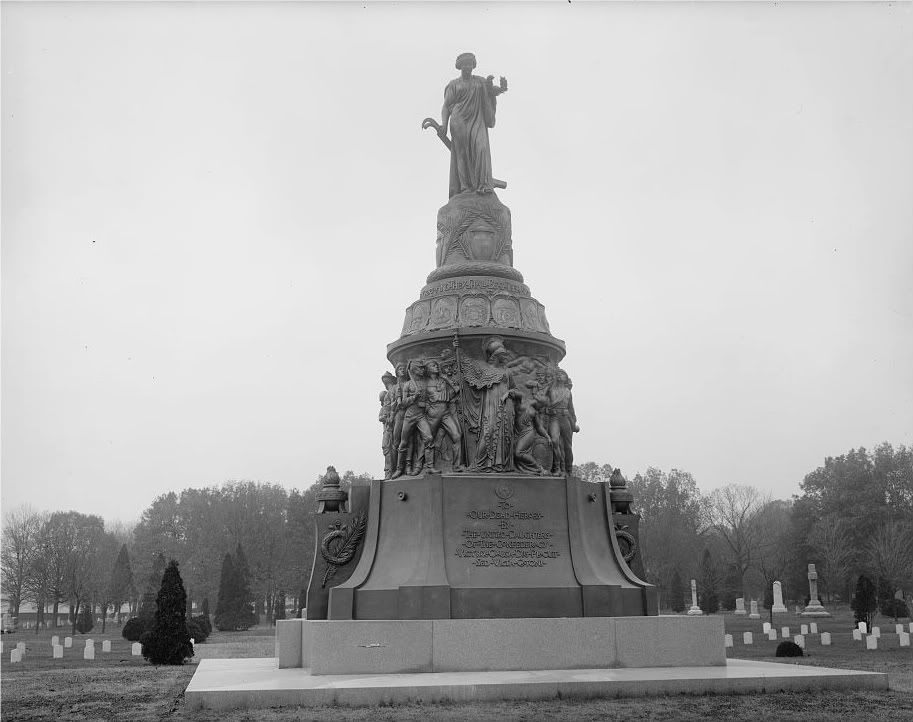

June 4, 1914 - Confederate Monument, Confederate Section, Arlington National Cemetery, Arlington, Virginia (USA). 32-foot monument designed by Moses Ezekiel [1844-1917]. "Topped by a woman representing the South...crowed by olive leves, her left hand extending a laurel wreath toward the South,... her right hand holding a pruning hook resting on a plow stock... Inscribed at her feet: "And they shall beat their swords into plow shares and their spears into pruning hooks." "Many historians believe it was the national call to arms during the Spanish-American War [1898-1902] that brought Northerners and Southerners together at last... In June of 1900, in this spirit of national reconcilation, the US Congress authorized that a section of Arlington Naitonal Cemetery be set aside for the burial of Confederate dead." -- From "Arlington National Cemetery: Shrine to America's Heroes" by James Edward Peters (1986).

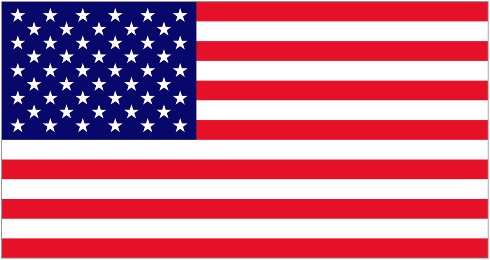
May 18, 1920 - Peace Cross Memorial, on grounds of the Cathedral of the Incarnation, Baltimore, Maryland (USA). "Celtic-style cross just north of Johns Hopkins Homewood Campus. Also known as Victory Cross. Dedicated to the memory of lives lost in World War I. Across the street is the Confederate Women of Maryland Monument. The monument is hidden from immediate view by some trees & resides in an area named Clover Hill, according to a Maryland Historical Society plaque found nearby. Around 1714, this region was part of a 210-acre grant by Lord Baltimore to Charles Merryman, whose descendents lived & farmed here until 1869. In 1909, the site was purchased by the Episcopal Church."

T
R
E
E
November 11, 1923 - Oak Tree, Arlington, Virginia (USA). "This is the memorial tree to the boys of Arlington killed in World War I. Of course, back then they only had one world war so it didn't have a number. It says the tree was planted in 1923. It doesn't seem old enough. I wonder if it was replaced."
C
R
O
S
S
July 13, 1925 - Peace Cross, US Highway 1, Bladensburg, Maryland (USA). Forty foot cross of cement and marble constructed by the Snyder-Farmer Post of the American Legion to recall the 49 men of Prince George’s County who died in World War I. Towers above the convergence of Baltimore Avenue, Bladensburg Road, and Annapolis Road (a primary entrance to Washington, DC, before the construction of interstate highways).

C
R
O
S
S
November 11, 1927 - Canadian Cross of Sacrifice, Arlington National Cemetery, Arlington, Virginia (USA). "A bronze sword adorning a 24-foot gray granite cross designed by Canadian architect Sir Reginald Bloomfield [1856-1942]." From cemetery website: "Few countries enjoy the bonds of goodwill & friendship that the US & Canada share. Our common border remains the longest unguarded frontier on earth, and our nations have shared triumphs and tragedies throughout history. It was in this spirit of friendship that in 1925 Canadian PM MacKenzie King [1874-1950] first proposed a memorial to the large number of US citizens who enlisted in the Canadian Armed Forces, and lost their lives during WW-I. Because Canada entered the war long before the USA, many Americans enlisted in Canada to join the fighting in Europe."
/// Lower image shows Cross of Sacrifice, Bayeux War Cemetery (France). Also by Canadian architect Sir Reginald Bloomfield [1856-1942]. "Usually present in Commonwealth war cemeteries containing 40 or more graves. It is normally a freestanding four point limestone Latin cross in one of three sizes ranging in height from 18 to 32 feet."




M
U
S
E
U
M
1927 - Colonial Williamsburg, Williamsburg, Virginia (USA). The quintessential recreation of a 18th-century community in colonial America. Uses "living history" to portray slaves as an essential part of society. Described on pages 68-69 of "A Traveller's Guide to the Civil Rights Movement" by Jim Carrier (2004).
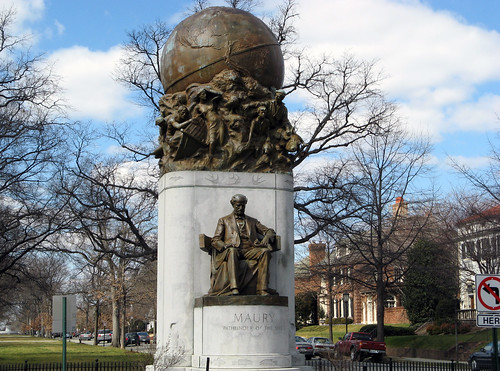

1929 - Monument to Matthew Maury, Monument Avenue, Richmond, Virginia (USA). Matthew Fontaine Maury [1806-1873] was an American naval officer, astronomer, historian, oceanographer, meteorologist, cartographer, author, geologist, and educator. Nicknamed "Pathfinder of the Seas," "Father of modern oceanography and naval meteorology," and later "Scientist of the Seas."


April 1932 - Peace, Victory & Valor, Tomb of the Unkinown Soldier, Arlington National Cemetery, Arlington, Virginia (USA). "On the East face of the Tomb you will find three figures, carved into the marble. This is the face most visitors to the Tomb do not see. The three figures, from left to right, represent Peace, Victory and Valor. Peace (on the left) is holding a dove in her left hand, while holding the right hand of Victory. Valor (on the right) is holding a broken sword in his hands and is facing Victory. Victory (in the middle) is holding the hand of Peace and extending an olive branch towards Valor. This symbolized the devotion and sacrifice that went with courage to make the cause of righteousness triumphant."


1935 - "Freedom of Conscience" statue, St. Mary's College of Maryland, 47645 College Drive, St. Mary's City, Maryland (USA). For tercentenary of Maryland. Inscribed "Presented by the [original] counties of Maryland." Sculpted by Maryland sculptor Hans Schuler [1874-1951].
M
U
S
E
U
M
1939 - Somerset Place State Historic Site, Lake Phelps, State Highway 64, 7 miles south of Creswell, North Carolina (USA). "Includes seven original 19th-century buildings, accurately representing the lives and lifestyles of the plantation's entire antebellum community." "Over the life of the plantation [1785-1865], three generations of owners, around 50 white employees, two free black employees, and more than 850 enslaved people lived and worked on the plantation." Described on pages 82-83 of "A Traveller's Guide to the Civil Rights Movement" by Jim Carrier (2004).


1939 - Japanese Monument, landward end of Luce Hall, US Naval Academy (USNA), Annapolis, Maryland (USA). "Presented to the Academy in 1939 by the family of the late Japanese Ambassador Hirosi Saito, who died in Washington, DC, that year."




September 2, 1940 - Great Smoky Mountains National Park (GSMNP), Tennessee & North Carolina (USA). 814 square miles (2,108 square kilometers) divided almost equally between the two states. Only US national park created entirely from privately owned land. Dedicated by President Franklin D. Roosevelt. Never called a "peace park" but meets all of the criteria of a "transfrontier conservtion area" (TFCA) as defined by the Peace Parks Foundation (PPF) or of a "transboundary protected area" (TBPA) as defined by the International Union for the Conservation of Nature (IUCN). Click here for other peace parks.

M
U
S
E
U
M
1948 - Museum of the Cherokee Indian, 589 Tsali Boulevard (US-441), Cherokee, North Carolina (USA). "Tells the story of the Eastern Band of Cherokee Indians, whose ancestors lived in these mountains for more than ten thousand years."
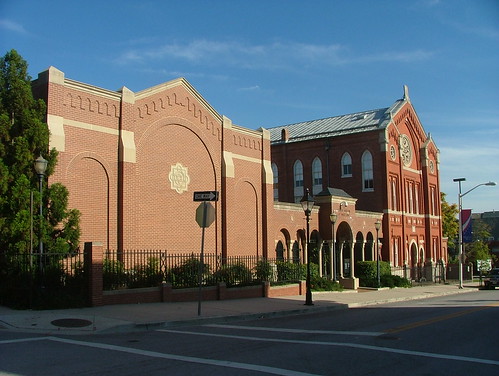
M
US
E
U
M
1960 - Jewish Museum of Maryland (JMM), Herbert Bearman Campus 15 Lloyd Street, Baltimore, Maryland (USA). The only museum in America with two historic synagogues, preserved and interpreted for the public.
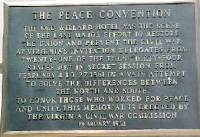

February 1961 - Peace Commission Plaque, Willard Hotel, Pennsylvania Avenue at 15th Street, NW, Washington, DC (USA). Text: "THE PEACE CONVENTION. The old Willard Hotel was the scene of the last major effort to restore the Union and prevent the Civil War. At Virginia's invitation, delegates from twenty-one of the then thirty-four states met in secret session from February 4 to 27, 1861, in a vain attempt to solve the differences between the North and South. To honor those who worked for peace and unity, this memorial is erected by the Virginia Civil War Commission, February 1961." Sadly, the meeting failed. By the time Lincoln was inaugurated five days later, seven states had resolved to secede from the Union. Less than two months later, the Civil War began.

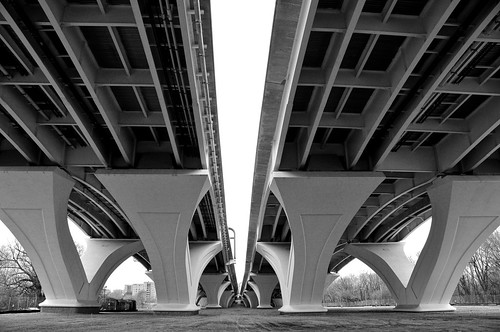


December 28, 1961 - Woodrow Wilson Memorial Bridge, Potomac River, between Alexandria, Virginia, & Oxon Hill, Maryland (USA). Woodrow Wilson [1856-1924] was president of Princeton University 1902-1910 & president of the USA 1913-1921. He received the 1919 Nobel Peace Prize. Bridge carries Interstate Highways 95 & 95 and opens for ships. Reconstructed 2006-2008. Wilson's widow died the same day that she was scheduled to dedicate the original bridge.


M
U
S
E
U
M
1964 - Marshall Museum & Research Library, Virginia Military Institute (VMI), Lexington, Virginia (USA). George C. Marshall [1880-1959] received the 1953 Nobel Peace Prize.


1969 - Quaker House, 223 Hillside Avenue, Fayetteville, North Carolina (USA). Near Fort Bragg. Slogan: "YES To The Troops. NO To The Wars."
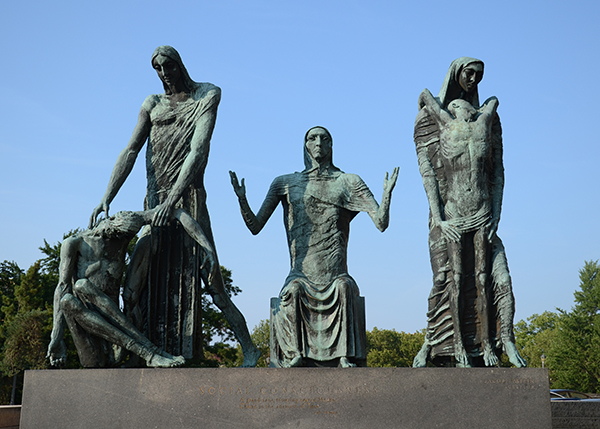

1972 - Statue of John Henry, Great Bend Railroad Tunnel, Talcott, West Virginia (USA). "The legend of John Henry, the “steel-drivin’ man” who beat the newfangled steel drill in a contest of strength & then died from exhaustion, is probably based on a real person. The statue was erected in 1972 by the Ruritan Club, then refurbished & moved closer to the tunnel entrance in 2012. Many of the workers, like John Henry, were newly-freed slaves. The legend is about both power & weakness, about persistence, about man vs. machine &, ultimately, the dignity of labor – with an African-American hero." This is "Monday's Monument" #54.
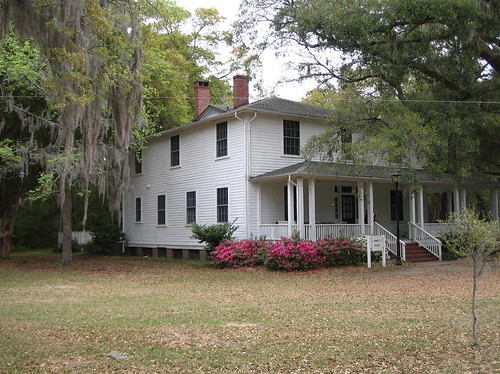

M
US
E
U
M
1974 - Penn School District & Museum (Penn Center), Land's End Road, Frogmore, St. Helena Island, South Carolina (USA). "Site of one of the country's first schools for freed slaves and one of the most significant African American historical and cultural institutions in existence today." Described on page 133 of "A Traveller's Guide to the Civil Rights Movement" by Jim Carrier (2004).

September 28, 1984 - Trios of Roadside Crosses by Rev. Bernard Coffindaffer, Christian Crosses, Inc., Craigsville, West Virginia (USA). "The Reverend Bernard Coffindaffer [1935-1993] began erecting the crosses in 1984. By the time of his death, 1,842 trios of crosses had been installed in 29 US states and in the Philippines. Coffindaffer spent over 3 million dollars on this project. Notice that the center cross is yellow and the other two, blue. Often, they are installed on heavily wooded mountaintops and we always wondered how on earth the Rev. Coffindaffer reached the upper ridges with them. One day, we saw this set near a gas station on US 19 in West Virginia and stopped to get a first hand look and to snap this photo. As you can see, the crosses are beginning to look worn and in need of a coat of paint." States with more than 50 trios: WV 352, FL 225, MS 156, GA 144, VA 131, NC 106, KY 94, TN 87, IN 80, PA 62 & MD 60.

M
U
S
E
U
M
June 8, 1985 - Public Hospital for Persons of Insane & Disordered Minds, Colonial Williamsburg, Williamsburg, Virginia (USA). First building in North America devoted solely to the treatment of the mentally ill. The first patient was admitted October 12, 1773. The reconstructed hospital has six exhibition cells open to the public in the first floor of the east wing and staff offices on the second story.


1986 - “Light Of Truth Universal Shrine” (LOTUS), Satchidananda Ashram, Integral Yoga Institute, Yogaville,Virginia (USA). Founded by Indian Swami Satchidananda [1914-2002]. "A monument to the Swamidananda’s interfaith vision of world harmony... Dedicated to the Light of all faiths and to world peace."



M
U
S
E
U
M
April 1987 - Frontier Culture Museum of Virginia, 1290 Richmond Road, Staunton, Shennadoah Valley, Virginia (USA). "This open-air living history museum comprises five farms which were dismantled at their original sites & meticulously reassembled on the property. The German farm from the village of Hordt dates to the 1600s. The Irish farm dates to the 1700s. The English farm from Worcestershire dates to the 1600s. The Virginia farm came from Botetourt County and dates to the 1800s. The newest addition is the Bowman House which stood in Rockingham County, Virginia, and dates to the 1700s." Formerly known as the Museum of American Frontier Culture.
M
U
S
E
U
M
1987 - Frisco Native American Museum & Natural History Center, Frisco, Outer Banks, North Carolina (USA). "Galleries filled with native art wind through the facility and include information on Native Americans across the United States as well as artifacts from the first inhabitants of Hatteras Island."
M
U
S
E
U
M
November 1987 - Charlotte Hawkns Brown Museum State Historic Site, Sedalia, North Carolina (USA). On former campus of the nationally-renowned Palmer Memorial Institute. "Links Dr. Charlotte Hawkins Brown [1883-1961] & Palmer Memorial Institute to the larger themes of African American history, women's history, social history, and education, emphasizing the contributions African Americans made in North Carolina." Described on page 98 of "A Traveller's Guide to the Civil Rights Movement" by Jim Carrier (2004).
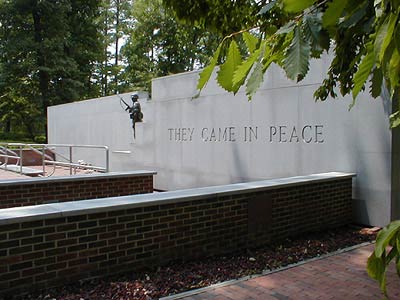

October 22, 1988 - Beirut Memorial, Lejeune Boulevard & Montford Landing Road, Jacksonville, North Carolina (USA). Near Camp Lejeune. Inscribed "They came in peace." Honors the 220 US Marines and 21 other servicemen killed on October 23, 1983, when their barracks in Beirut were destroyed by a suicide bomber driving a truck full of explosives.

November 6, 1988, The Flame, Baltimore Holocaust Memorial, Lombard & Gay Streets, Baltimore, Maryland (USA). 11-foot tall bronze sculpture. Depicts emaciated concentration camp inmates huddled together and being consumed by a fire. Sculped by Joseph Sheppard. Made by Fonderia Massimo Del Chiaro in 1987. Added to Arthur D. Valk's original (1980) Holocaust Memorial. Remained when Valk's work (which had "become a haven for illicit activity") was replaced by a new memorial designed by Lynn Katzen & architect Jonathan Fishman and dedicted October 6, 1997. Criticized for its explicit and graphic details, for being commissioned outside normal channels, and because it was an add on to the existing Valk work. Inscription around the top of the 6-foot cylindrical blanck granite base: "Those who cannot remember the past are condemed to repeat it." - George San Tayana [sic], 1863-1952.

September 30, 1989, Sequoyah," Museum of the Cherokee Indian, 589 Tsali Boulevard (US-441), Cherokee, North Carolina (USA). 22-foot wooden statue. Carved by Hungarian-American Peter Wolf Toth from a single Sequoia log from California. #63 in a series of "Whispering Giants" carved by Toth in every state. Statues #64, #71 & #72 are also in North Carolina.
M
U
S
E
U
M
Spring 1990 - Woodrow Wilson Presidential Library & Museum, Staunton, Virginia (USA). "Nation's only facility with professionally researched & designed interpretive galleries exploring the life and public service of Woodrow Wilson [1856-1924], the 28th President." Wilson received the Nobel Peace Prize in 1919.


Early 1990's - Nyingma Tibetan Buddhist Temple & Stupa Peace Park, Kunzang Palyul Choling (KPC) of Maryland, 18400 River Road, Poolesville, Montgomery County, Maryland (USA), near Washington, DC. 65-acre peace park. See similar stupa & peace park in Sedona, Arizona (USA).

T
R
E
E
September 12, 1992 - Vandalized August 8, 1996 - WVU "Peace Tree," West Virginia University, Morgantgown, West Virginia (USA). "Commemorates the University's commitment to the rediscovery of America's Indian heritage. Chief Leon Shenandoah, Tadodaho (Presiding Moderator) of the Grand Council of the Haudenosaunee Six Nations Iroquois Confederacy, & Chippewa Chief Robert TallTree, also a musician, artisan and storyteller, were invited to plant & bless the tree. On August 8, 1996, vandals cut down the Peace Tree. A second Peace Tree, which still stands today, was planted by Mohawk Chief Jake Swamp on October 19, 1996. /// According to Haudenosaunee oral tradition, the Creator sent a Peacemaker to unite the warring Seneca, Cayuga, Oneida, Mohawk & Onondaga Nations by planting the original Tree of Peace at Onondaga [New York] ca. 1000 A.D. The Tree marked the formation of the Haudenosaunee Six Nations Iroquois Confederacy. As told by Chief Jake Swamp, when the Tree was planted, the Peacemaker told the first leaders: 'This will be the symbol that we will use. The white pine will be the symbol of peace. Now the greenery of this tree will represent the peace you have agreed to. Every time you look at this tree and its greenery, you will be reminded of this peace you agreed to because this tree never changes color the year round, it's always green, so shall be your peace.'"
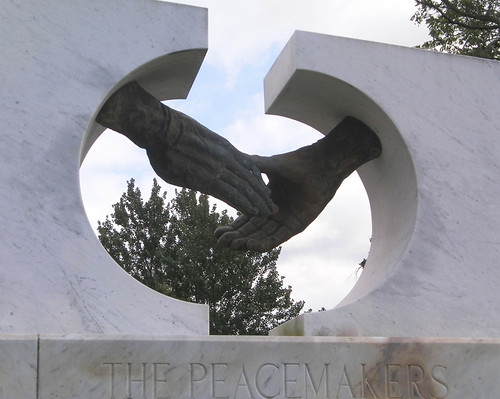


October 22, 1992 - Peacemakers Monument, Shenandoah University, Winchester,Virginia (USA). Commemorating the handshake between President Ronald Reagan and Mikhail Gorbachev on December 7, 1987.
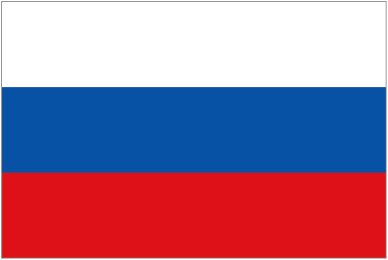

1990 - Peacemakers Monument, Federation of Peace and Conciliation, 36 Prospect Mira, Moscow (Russia). Commemorating the handshake between President Ronald Reagan and Mikhail Gorbachev on December 7, 1987.



Date? - Peace Candle, West 2nd Street, Frederick, Maryland (USA). "In a private home's yard, a towering dead tree trunk has been carved to resemble a lit candle with the word "PEACE" affixed to it."
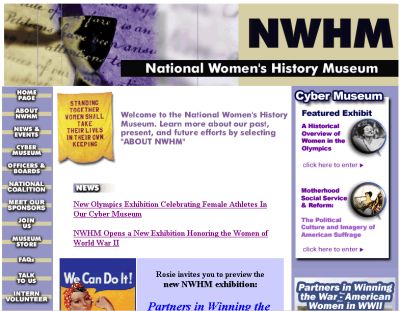
M
U
S
E
U
M
1996 - National Women's History Museum (NWHM), 205 South Whiting Street (Suite 254), Alexandria, Virginia (USA). "Educational institution dedicated to preserving, interpreting, and celebrating the diverse historic contributions of women, and integrating this rich heritage fully into our nation's history." Now in cyberspace but campaigning to build physical museum on the National Mall in Washington, DC.

M
US
E
U
M
1996 - National Museum of Civil War Medicine, 48 East Patrick Street, Frederick, Maryland (USA). "Interactive educational programs, exhibits, seminars and lectures provide the knowledge that Civil War medicine connects us not only to our past, but is the scientific and historical link to our present and our future."
M
U
S
E
U
M
August 31, 1998 - Robert Russa Moton Museum, Main Street & Griffin Boulevard, Farmville, Virginia (USA). "Site of R.R. Moton High School where in 1951 the student body walked out in protest of unequal educational facilities." Described on pages 48-50 of "A Traveller's Guide to the Civil Rights Movement" by Jim Carrier (2004).
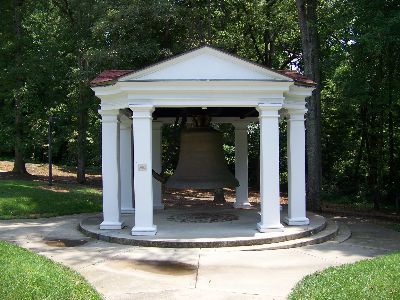
B
E
L
L
December 31, 1999 - American Freedom Bell, 3500 Shamrock Drive, Charlotte (North Carolina). Seven feet tall, seven feet wide, and weighing seven tons. "World's largest bell at ground level." Dedicated on the eve of the new millenium. "Jewish conceived" (i.e. largely paid for by the Belk department store fortune). Between the new Charlotte Museum of History and the old (1774) Hezekiah Alexander rock house. "Marks Charlotte as the first focus of freedom from Britain with its Mecklenburg Declaration of Independence publicly signed [in 1775] 14 months before the Philadelphia document."


2000 - Northeast Interfaith Peace Garden, St. Anthony of Padua Church, Baltimore, Maryland (USA). "Since 2000, the Garden has continued to grow, so that as you stroll through today, you’ll find [a labyrinth ... ] flowering trees and shrubs that change with the seasons … a steppingstone footpath that winds its way through a perennial garden … a lighted fountain and pool that provide the relaxing sound of bubbling water … teak benches that sit in light and shadow … journals where you can record your reflections, and read the inspirational thoughts of others who have come to the Garden."



October 14, 2000 - Garden for Peace , Culberson Asiatic Arboretum, Sarah P. Duke Gardens, Durham, North Carolina (USA).


2002 - Peace Garden, Epiphany Chapel & Church House, Odenton, Maryland (USA). Honors the 2,929 military chaplains who served in World War I. "'The garden is a crowning tribute to the faith and courage of chaplains who served the needs of more than 100,000 men and women that passed through Camp Meade [now Fort Meade] on their way to the trenches in France,' said the Rev. Phebe McPherson, rector at the chapel for 22 years. The garden, with benches and five bronze plaques bearing the names of every World War I chaplain, is located under shade trees by the chapel's front door." One of 100 "sacred spaces" created by the TKF Foundation 1996-2008.



October 13, 2003 - Garden for Peace , Charlottesville Historical Society Garden (downtown), Charlottesville, Virginia (USA).

April 23, 2004 - Tribute to Judge Matthew J. Perry, Jr., Columbia, South Carolina (USA). Sculpted by Mariah Kirby-Smith. Depicts civil rights pioneer Matthew J. Perry, Jr. [1921-2011], South Carolina's first African-American United States District Judge, talking to three children.
M
U
S
E
U
M
June 25, 2005 - Reginald F. Lewis Museum of Maryland Aftican American History & Culture, 830 East Pratt Street, Baltimore, Maryland (USA). "Sharing the courageous journeys toward freedom and self-determination made by African American Marylanders." A Smithsonian Affiliate.



2005 - "Reconciliation: The Parable of the Prodigal Son," Divinity School, Duke University, Durham, North Carolina (USA). By Margaret Adams Parker. See Luke 15:11-32.




September 11, 2005 - Peace Garden, St. Anthony of Padua Church, Falls Church, Virginia (USA). "Eleven Peace Poles create a dramatic entrance into the sacred space. Christian & Muslim faith communities, as well as public and private schools, helped create the unique poles crafted of various media. Incorporated into their design are symbols of peace from many different cultures." One of 100 "sacred spaces" created by the TKF Foundation 1996-2008.



October 2006 - Statue of Walter Reuther, Oglebay Park, Wheeling, West Virginia (USA). On Ohio River. Born in Wheeling, Walter Reuther [1907-1970] was "an American labor union leader, who made the United Automobile Workers a major force not only in the auto industry but also in the Democratic Party in the mid 20th century." He was a socialist in the early 1930s and became a leading liberal and supporter of the New Deal coalition.. "The larger-than-life statue, commissioned by the UAW, was sculpted by Zanesville, Ohio, artist Alan Cottrill. It features Reuther in shirtsleeves, gesturing as if speaking to a crowd."

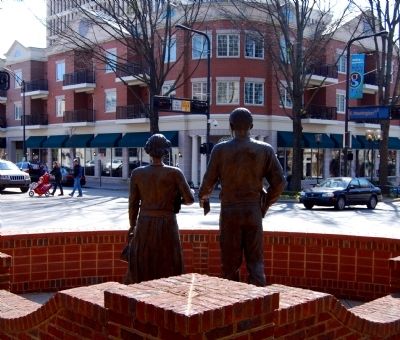

November 19, 2006 - Statue of Two Sterling High School Students, Main Street at Washington Street, Greenville, South Carolina (USA). Sculpted by Mariah Kirby-Smith. Celebrates the students of Greenville's black high school whost protests and sit-ins helped bring about racial integration in 1970. At site of Woolworth department store where sit-ins took place. The former store was torn down c.2011 and, as of 2012, is being replaced by a new multi-use building called Washington Square.



March 30, 2007 - "Reconciliation Triangle," Richmond, Virginia (USA). On site of a former slave market. One of 5 identical monuments by Stephen Broadbent expressing remorse for the slave trade. The others are in Liverpool (England), Belfast (Northern Ireland), Glasgow (Scotland) & Benin (Africa).


September 11, 2008 - Pentagon Memorial (9/11), The Pentagon, Department of Defense, Arlington, Virginia (USA). A permanent outdoor memorial to the 184 people killed in the building and on American Airlines Flight 77 in the September 11, 2001 attacks. Click here for the Wikipedia article.




September 2008 - Place of Peace, Furman University, Greenville, South Carolina (USA). "Connect with the environment, reflect, and achieve a deep calm. The Asia Garden, water feature & an authentic Japanese temple harmonize to create the Place of Peace [from campus map]." /// "Once a family temple in Japan, the Place of Peace is part of the Asia Studies Program & is used to teach Japanese architecture & culture. Reconstructed in 2008, one can see an authentic Japanese temple, look inside upon appointment & be surrounded by Japan in South Carolina." Gift of the Tsuzuki family of Nagoya (Japan).



March 26, 2009 - Serenity Garden, DPU Centennial Park, Orangeburg Memorial Gardens, Seeboard Street, Orangeburg, South Carolina (USA). "'I want all of the citizens from Orangeburg and the surrounding areas to have a place to come and meditate and have peace,' said Theo Martin, administrator of UniHealth Post-Acute Care. 'I think in all of our lives, we need to have peace and have that inner peacefulness.'"



September 20, 2009 - Peace & Justice Plaza, Chapel Hill, North Carolina (USA). Renaming of the Old Post Office Plaza. " The following individuals currently are honored on the historic marker: Charlotte Adams, Hank Anderson, James Brittian, Yonni Chapman, Rebecca Clark, Joe Herzenberg, the Rev. Charles M. Jones, Dan Pollitt, Mildred Ringwalt, Hubert Robinson, Joe Straley, Lucy Straley & Gloria Williams. Nominees for the marker must have demonstrated a lifelong commitment to furthering the causes of peace & justice in Chapel Hill, & they are individuals who are no longer living."



October 3, 2009 - Mahatma Gandhi Memorial Statue, Gandhi Park, Old County Courthouse, Trade & Alexander Streets, Charlotte, North Carolina (USA). Dedicated by Charlotte Asian Heritage Association (CAHA).

M
U
S
E
U
M
February 1, 2010 - International Civil Rights Center & Museum, in the original 1929 F.W. Woolworth building, South Elm Street, Greensboro, North Carolina (USA). Dedicated on the 50th anniversary of the sit-in movement. Has 14 exhibits focusing on the international struggle for civil and human rights, as well as artifacts from the civil rights era. Centerpiece is the historic lunch counter & original stools where four North Carolina A&T State University freshmen (Ezell Blair Jr., Franklin McCain, David Richmond & Joseph McNeil) sat down in nonviolent protest on Feb. 1, 1960. Co-founded by Melvin “Skip” Alston and Earl Jones. Entry #773 in the "Peace Movement Directory" by James Richard Bennett (2001).



May 27, 2012 - "Lady Liberty Stolen from Occupy Raleigh: Irony Not Lost on Occupiers", Raleigh, North Carolina (USA). "By Roger Ehrlich. A 20 foot pop-art “Leaning Lady Liberty” statue, which had become one of the symbols of Occupy Raleigh and was a familiar site to downtown Raleigh motorists, was stolen from the corner of Edenton and West Streets between Friday, May 18 afternoon and early Saturday, May 19 morning. “The statue belonged to all of us,” said Occupy supporter Roger Ehrlich, who helped create it, “I know people loved it, and not just the occupiers. They would lean out their car windows to take pictures, a local artist painted a picture of her standing in front of the tents. Now it’s been stolen, just like people’s Constitutional Rights and economic security have been stolen.” The statue showed civilians attempting to resurrect a leaning Statue of Liberty in a formation reminiscent of another iconic image, the statue of U.S. Marines planting a flag at Iwo Jima. It was featured in a recent News 14 story about the closing of the resource center. The owner of the property said the statue could stay at least through the end of May. Citizens have erected a sign where the “Leaning Lady Liberty” used to stand and distributed handbills with her image in the hopes that the community can help get her back. Two harassing phone calls received at 3:30 and 4:00 a.m. Monday, May 21 by an Occupy Raleigh participant suggest that the statue may have been stolen by opponents of the movement. “A lot of people are disturbed with what’s been happening with financial fraud, the wars, and how corporate money rules,” said Ehrlich, “but people have different ideas about what should be done. We’ve gotten some opposition from people who claim to be patriots, and with recent events like veterans in Chicago returning their medals to protest the wars and fraud I know emotions are running high. We don’t know who took it, but I’d like to ask those people, ‘do they hate the dissent that has spread liberty throughout the world? Do they hate freedom?” Raleigh supporters of the Occupy Wall Street movement began by occupying space at the State Capitol last fall, but their claims of the right to 24 hour public assembly and speech at the square fell on deaf ears and they were forced to move temporarily to the private but visible location downtown. When occupiers shut down the resource center where the statue stood, they vowed to redirect their energy into other efforts such as instituting new limits on corporate political influence and holding those guilty of financial crimes accountable. Contact: Rachel Powell (337) 580-4559 Roger Ehrlich (919) 696-5995



May 26, 2014 - “Swords to Plowshares” memorial, Raleigh, North Carolina (USA). Also called "a mobile Armistice Bell Tower & 'Swords to Plowshares' Peoples History Exhibit." /// "...a 24-foot tower made of recycled metal, a rolling hat-tip to all victims of war... It stands temporarily alongside the N.C. State University Memorial Belltower, manned 24 hours a day. Roger Ehrlich & [the] Veterans for Peace, hope visitors will remember that this year marks the 100th anniversary of the start of World War I, the 'war to end all wars.' It killed 16 million people, introducing the world to chemical warfare, flamethrowers & tanks. The Wolfpack Belltower itself was built [in 1937] to honor those veterans, and this dedication appears on its side: 'In memory of those who served their country in the world war.' On the tower’s door, it reads, 'and they shall beat their swords into plowshares...' The [mobile] monument will travel to the Veterans for Peace convention in Asheville in July 2014." /// Includes bell forged with the date 1886 in Hillsboro, Ohio, & discovered at the construction site of the Church of Reconciliation in Chapel Hill, NC. /// Information courtesy of Roger Ehrlich, Cary, NC.

October 4, 2016 - "Statue of Dr. George Simkins," Greensboro, North Carolina (USA). Simkins was a "longtime civil rights activist & Greensboro dentist, who served as the president of the Greensboro Branch NAACP from 1959 to 1984. In 1955, Simkins & several other Black men were arrested for trespassing after they played nine holes at the all-White, city-owned Gillespie Park Golf Course. He and the others appealed their convictions all the way to the US Supreme Court, which ruled against them by a 5 to 4 vote. NC Gov. Luther Hodges later commuted their sentences... The statue was presented by the Joseph M. Bryan Foundation & the Community Foundation of Greater Greensboro."
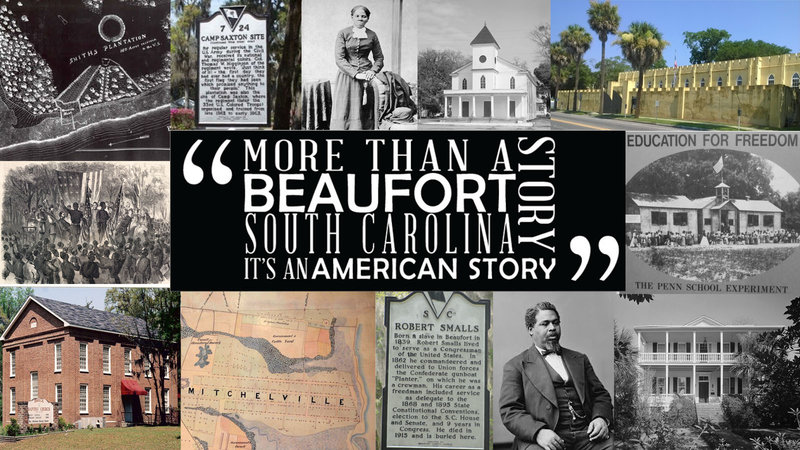

January 12, 2017 - Reconstruction Era National Monument, Beaufort County, South "Carolina (USA). "Commemorates a post-Civil War community of freed slaves [the Penn Center]" & possibly the Brick Baptist Church, the Robert Smalls house, the site at the Naval Hospital in Port Royal (where the Emancipation Proclamation was read publicly to great fanfare on New Year’s Day 1863), and the old firehouse in downtown Beaufort." /// One of 5 new national monuments decreed at the same time by outgoing President Barak Obama under the Antiquities Act of 1906.

March 11, 2017 - Hariet Tubman Underground Railroad Visitors Center, Church Creek, Eastern Shore, Maryland (USA). "A $21 million project that commemorates Tubman’s journey, from slave to Underground Railroad 'conductor' &, later in life, Civil War scout, spy & nurse. Sitting on 17 acres, the center will be part of the Harriet Tubman Underground Railroad Byway, a 125-mile self-guided driving tour that wends through 36 significant sites along the Eastern Shore." A partnership of the National Park Service & the Maryland State Park Service, the Harriet Tubman Underground Railroad Visitor Center. "Harriet Tubman Underground Railroad National Historical Park is a new park contained within the Harriet Tubman Underground Railroad National Historical Monument."


Date? - Interactive Peace Museum, La Paix Herb Farm, 3052 Crooked Run Road, Alum Bridge, West Virginia (USA). A project of Myra Bonhage-Hale. Mentioned in Tom Flores (2008). This project has probably been abandoned.



M
U
S
E
U
M
Future - US National Slavery Museum, 1320 Central Park Boulevard (Suite 251), Fredericksburg, Virginia (USA). Designed by C. C. Pei. Intended for construction on National Mall in Washington, DC? "Will offer 100,000 feet [sic] of permanent and temporary exhibit space. Exhibits will take visitors on a journey through time, beginning with Africa as the cradle of civilization through the Middle Passage on slave ships, to the slave resistance movement, the Civil War and the continuing struggle for equality today."

M
U
S
E
U
M
Future - Cold War Museum, site of Lorton Nike Missile Base, Lorton, Virginia (USA). "In 1996, Francis Gary Powers, Jr. and John C. Welch founded the Cold War Museum to preserve Cold War history and honor Cold War Veterans. Currently, a mobile exhibit of historical artifacts associated with the U-2 Incident of May 1960 is traveling around the world promoting interest in the creation of a permanent Cold War Museum facility."


Future - International Peace Museum, Weston Hospital (former Trans-Allegheny Lunatic Asylum), Weston, West Virginia (USA). Proposed by Myra Bonhage-Hale, La Paix Herb Farm, 3052 Crooked Run Road, Alum Bridge, West Virginia (USA). See photo of Bonhage-Hale at "May Peace Prevail on Earth" fountain in Fayetteville, Arkansas. Website is no longer promotes the museum, so project is abandoned?